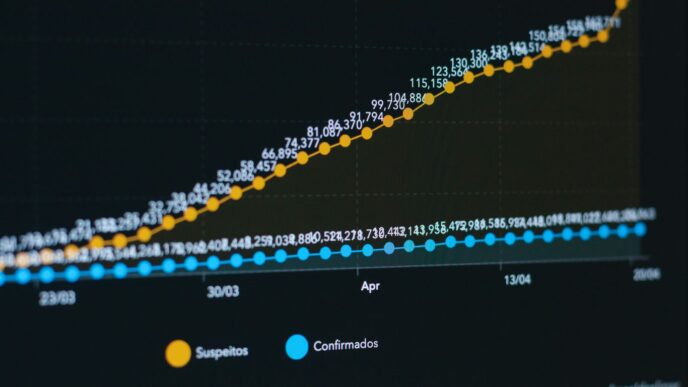The world of Software as a Service (SaaS) is changing fast. It’s not just about having software online anymore. By 2025, the market is huge and still growing, with new ideas popping up all the time. Companies that are doing really well are the ones using smart tech like AI, making software just for specific industries, and finding real ways to use new technologies. We’re looking at the fastest growing SaaS companies to see what makes them tick.
Key Takeaways
- AI is no longer just a buzzword; it’s being used to create software that actually gets things done and shows real results.
- Software made for specific industries (vertical SaaS) is becoming super important because it solves unique problems better than general tools.
- New technologies like blockchain and AR/VR are finding practical uses in SaaS, especially for things like security and training.
- Companies are focusing on keeping customers happy and getting them to spend more over time (net dollar retention) rather than just getting new customers.
- Security is a huge deal, with new approaches like Zero Trust and Security Mesh becoming standard for protecting data and systems.
The Evolving Landscape of SaaS Innovation
SaaS in 2025 feels less like building another app, and more like playing chess in a hurricane. Change shows up on your doorstep almost every week now. The big buzzwords from two years ago—cloud-first, subscription-only—are less exciting; most people already expect them. Instead, people are talking about smarter features, apps built for their industry, and tech that finally solves real headaches. Here’s how the scene is shifting right now:
AI-Powered Features Driving Measurable Results
Everyone claims to use AI, but some SaaS companies are actually getting real results with it. These days, you won’t win customers with generic “AI-powered” labels—folks expect:
- Predictive tools that save time, not just add noise.
- Smart automation that reduces manual work (like auto-filling complex data or sorting support tickets).
- Personalized recommendations that fit workflows, not just upsell more features.
Let’s look at a simple breakdown:
| Company | AI Feature | Tangible Benefit |
|---|---|---|
| Sobot | Chatbot automation | 50% lower support cost |
| Draftwise | Document review | Cuts review time by 40% |
| Receptix | Real-time alerts | 20% boost in retention |
Most SaaS buyers now measure AI by impact, not hype. That means if the feature doesn’t save money, save time, or generate revenue, it’s ignored.
Vertical SaaS Tailored for Industry-Specific Needs
Generic SaaS is losing steam. In 2025, the fastest-growing companies are those that pick their lane and build for one field—like construction, law, or retail—because:
- Industry compliance rules might trip up general platforms.
- Workflows are specialized, so a one-size-fits-all approach flops.
- Niche apps tend to show higher retention (nobody likes training their staff twice).
For example, a SaaS platform for healthcare tracks new HIPAA rules automatically, while a legal app handles e-discovery without needing heavy customization. Going vertical also means deeper integrations with industry data sources. That saves admins headaches, and keeps teams loyal.
Emerging Technologies Finding Real-World Applications
Remember when blockchain and AR sounded like science fiction? Well, now they quietly work behind the scenes in SaaS tools:
- Blockchain helps track sensitive documents, building trust with customers worried about data leaks.
- AR (augmented reality) is showing up in SaaS for training—imagine remote field techs getting virtual repair guides onscreen.
- Low-code and no-code tools let teams outside IT build just-what-they-need apps without waiting weeks for developers.
In 2025, what matters isn’t how flashy the tech is—it’s whether it actually solves a real, annoying problem. More often than not, the tools that win are the ones you almost don’t notice—they just work.
Key Growth Drivers for SaaS Companies in 2025
Focus on Net Dollar Retention and MRR
Net Dollar Retention (NDR) and Monthly Recurring Revenue (MRR) are the scoreboard for SaaS success in 2025. If you want a healthy business, you can’t just chase new logos—you have to keep and grow the ones you already have. SaaS leaders now follow MRR broken down by cohort or even geography. Expansion revenue (upsells, add-ons, and seat increases) is no longer a side note. Here’s how the key metrics stack up in board meetings:
| Metric | Why It Matters |
|---|---|
| Net Dollar Retention | Shows true account growth |
| MRR | Predictable revenue stream |
| Gross Churn Rate | Red flag if trending up |
| Expansion MRR | Healthier than new sales |
If you’re not moving these numbers upwards, you’ll feel it soon enough—maybe not this quarter, but definitely by end of year.
Optimizing Customer Acquisition Cost and Payback Periods
Getting in front of customers is getting pricier every month. Advertising is crowded, and buyers are skeptical. That’s why SaaS companies are obsessed with their Customer Acquisition Cost (CAC), especially how quickly a new customer pays back what it cost to land them. A short payback period means your marketing isn’t leaking money.
Three practical tips most teams are following right now:
- Target high-fit leads with tighter ICP (Ideal Customer Profile) selection, not spray-and-pray ad spend
- Automate demos and onboarding to reduce human sales hours
- Track CAC by channel; double down on the ones that actually convert
If your CAC payback stretches beyond twelve months, it’s a red flag. Investors in 2025 won’t wait around for sluggish returns.
Minimizing Churn and Enhancing Product Engagement
You can’t sugarcoat it—churn is the silent killer in SaaS. Every time a customer leaves, your growth hits a speed bump. And in 2025, losing users isn’t tolerated as a “nature of the business” issue; it’s something companies actively go to war against.
To fight churn, leading SaaS teams are doing this:
- Fast, helpful onboarding: If users don’t get early value, odds are they’ll ghost you.
- Proactive customer success: Not just answering support tickets, but reaching out, checking usage, and helping customers hit milestones.
- In-app engagement: Nudges, tutorials, and new feature highlights right where users work boost stickiness.
And it’s not all about the numbers. Sometimes checking in with someone before they click "cancel" is what keeps your revenue engine running smooth. If you’re not obsessed with why someone logs in, or why they stopped, you’re already behind.
Transformative Trends Shaping the SaaS Market

The SaaS world isn’t standing still in 2025—far from it. There are a few big shifts going on that are changing how everybody builds, buys, and uses cloud software. Let’s walk through what’s actually moving the needle this year.
The Rise of Ambient Intelligence and Zero-UI
SaaS in 2025 is slipping quietly into daily life with ambient intelligence—no more shouting at your computer or wading through endless menus. These new platforms blend into your workflow and anticipate your needs. Tasks can be automated based on context, and you might never even look at a traditional app interface. Instead, there’s:
- Voice-based and gesture control, so you can work hands-free
- Invisible automation running in the background (scheduling, reminders, approvals)
- Real-time predictions, surfacing the information you want before you even ask
A few years ago, SaaS needed you to click and tap everywhere. Now? It just works—even if you can’t see it.
Increased Regulatory Scrutiny and Privacy Expectations
It’s not just tech folks caring about privacy—regulators are watching closely, and customers expect better, too. It used to be that only large companies worried about data rules, but this year, everyone selling SaaS is:
- Building for data privacy regulations in different places (GDPR, CCPA, and whatever’s next)
- Baking compliance tools right into products, not as an afterthought
- Publishing clear privacy dashboards so users know what data lives where and why
Mess up privacy, and you not only risk fines—you could lose users overnight. The bar for trust is the highest it’s ever been.
Sustainability and Carbon Accounting in SaaS
It’s not just customers asking about cloud features—they’re asking about the carbon footprint, too. Whether it’s a procurement checklist or public pressure, SaaS vendors are:
- Tracking the energy impact of infrastructure across regions
- Reporting on carbon use as a standard metric for new deals
- Offering "green" options (renewable-energy regions, optimized server usage)
Here’s a quick comparison that’s showing up on more bids:
| Metric | 2023 | 2025 |
|---|---|---|
| Vendors tracking CO₂ | 18% | 44% |
| Carbon data in RFPs | Few | Almost all |
| Green data centers | Niche | Common offering |
Even if it feels like overkill sometimes, the winners will be those who figure out their environmental story just as seriously as they do their product roadmaps.
So, in 2025, real SaaS growth means adapting—sometimes quietly, sometimes loudly—to how people expect software to fit into their lives, their rules, and now, their planet.
Strategic Imperatives for SaaS Success
Look, the SaaS world in 2025 isn’t exactly a walk in the park. Things are moving fast, and what got you here won’t get you there. Companies that are really making waves aren’t just building cool software; they’re building businesses that can actually handle the speed and the changes. It’s about being smart, not just busy.
Designing for Adaptability and Resilience
Remember when you could just launch a product and assume it would work for years? Yeah, those days are pretty much over. The market shifts, customer needs change, and new tech pops up constantly. So, how do you keep up?
- Build with flexibility in mind. Think modular. Can you swap out a component if a better one comes along? Can you scale up or down easily without a massive overhaul?
- Listen to your users, like, really listen. Their feedback isn’t just nice-to-have; it’s your roadmap. Are they struggling with a feature? Is there something they desperately need that you’re not providing?
- Have a plan for the unexpected. What happens if a major competitor launches something similar? What if a new regulation hits? Having contingency plans, even basic ones, can save you a lot of headaches.
Cutting Through the Noise: Focusing on Signal
It feels like there’s a new tool or feature announced every other day. It’s easy to get distracted by all the shiny new things. But for SaaS companies, the real win is figuring out what actually matters to your customers and your business.
- Know your core value. What problem are you solving better than anyone else? Double down on that. Don’t get sidetracked by every trending feature if it doesn’t serve your main purpose.
- Track the right metrics. Forget vanity numbers. Focus on things like Net Dollar Retention (NDR) and how much revenue you’re actually growing from existing customers. Also, keep a close eye on your Customer Acquisition Cost (CAC) and how long it takes to get that money back.
- Simplify the user experience. Customers are tired of complex software. If your product is hard to use or requires a ton of training, they’ll look elsewhere. A clean, intuitive interface is often more valuable than a dozen complex features.
Engineering Momentum for Responsible Scaling
Growth is great, but not if it breaks your company. Scaling responsibly means building a solid foundation so you can grow without everything falling apart. It’s about smart growth, not just fast growth.
- Automate where you can. Repetitive tasks eat up time and resources. Look for opportunities to automate customer support, onboarding, and internal processes.
- Invest in your team. As you grow, your team needs to grow with you. Make sure you’re hiring the right people and giving them the tools and training they need to succeed.
- Keep security front and center. As you scale, you become a bigger target. Implementing things like Zero Trust architecture and a Security Mesh framework isn’t just good practice; it’s necessary to protect your company and your customers’ data.
The Impact of Emerging Technologies on SaaS
Okay, so we’ve talked a lot about AI and how it’s basically everywhere now, right? But what else is shaking things up in the SaaS world? It feels like every week there’s some new tech buzzword, and it’s hard to keep track of what’s actually going to stick and what’s just hype. Let’s break down a few of the big ones that are starting to make real waves.
Blockchain for Enhanced Data Integrity and Auditability
Remember when blockchain was all about Bitcoin? Well, it’s grown up a bit since then. For SaaS companies, especially those dealing with sensitive data or needing to prove compliance, blockchain is becoming really interesting. Think about it: every transaction, every data point, can be recorded on an immutable ledger. This means you get a super clear, tamper-proof history of everything that’s happened. For audits, this is a dream. No more digging through old logs hoping you find what you need; the blockchain has it all, verified and timestamped.
- Immutable Records: Once data is on the blockchain, it’s incredibly hard to change or delete. This is huge for compliance and trust.
- Enhanced Audit Trails: Imagine easily proving who did what, when, and why. It simplifies audits significantly.
- Data Provenance: You can track the origin and journey of data, which is vital for many industries.
It’s not just for finance anymore; industries like supply chain, healthcare, and even legal services are looking at how blockchain can make their SaaS tools more trustworthy.
Web3 Tools Maturing for Authentication and Licensing
Web3 is another one of those terms that can sound a bit out there, but the underlying ideas are starting to show up in practical ways for SaaS. We’re talking about things like decentralized identity and better ways to manage digital assets. For SaaS providers, this could mean more secure ways for users to log in without relying solely on big tech identity providers. It also opens up new models for licensing software, potentially moving beyond simple subscriptions to more flexible, ownership-based systems. This shift could fundamentally change how users interact with and pay for software services.
- Decentralized Identity: Users control their own digital identities, leading to more secure and private logins.
- Token-Based Licensing: New ways to manage software access and usage rights, potentially offering more granular control.
- Smart Contracts: Automating agreements and payments directly within the software, reducing administrative overhead.
While still early days for widespread adoption, the concepts behind Web3 are pushing SaaS towards more user-centric and secure models.
AR/VR Niches in Vertical SaaS for Training and Healthcare
Augmented Reality (AR) and Virtual Reality (VR) have been around for a while, but they’re finally finding their footing in specific business applications, especially within vertical SaaS. Instead of just being for games, AR and VR are becoming powerful tools for training employees in complex or dangerous jobs. Imagine a mechanic learning to fix a new engine with AR overlays guiding them, or a surgeon practicing a procedure in a VR simulation. Vertical SaaS platforms are starting to integrate these technologies to offer highly specialized training modules that are more effective and safer than traditional methods.
- Immersive Training: AR/VR allows for hands-on practice in realistic, simulated environments, improving skill retention.
- Remote Assistance: Experts can guide on-site personnel through complex tasks using AR, no matter the distance.
- Healthcare Applications: From surgical planning to patient education and therapy, VR is showing real promise.
These aren’t just futuristic ideas anymore; they’re becoming practical tools that solve real problems for businesses in specific sectors, making vertical SaaS even more valuable.
Navigating the SaaS Market Dynamics
So, what’s really going on in the SaaS world as we hit 2025? It feels like things are moving at warp speed, and honestly, it’s a bit of a whirlwind. The days of just throwing a bunch of apps at a problem are fading fast. Buyers are tired of juggling too many tools, and frankly, so are the companies trying to sell them. This is leading to some big shifts, and if you’re not paying attention, you might get left behind.
The Role of Mergers, Acquisitions, and Consolidation
Let’s be real: the SaaS landscape is consolidating. It’s not just a few big players buying up smaller ones anymore. We’re seeing a lot more activity across the board. Why? Well, a few things are pushing this.
- Feature Fatigue is Real: Customers are overwhelmed. They don’t want a dozen different apps to do one job. They’re looking for platforms that offer a more integrated experience. This means companies are either building out their own platforms or buying the features they need to get there faster.
- Private Equity is Hungry: Those private equity firms? They’re actively buying up mid-market SaaS companies. They often streamline operations – which sometimes means cutting costs – and then bundle these companies together. It’s a strategy that’s definitely changing the ownership structure of many businesses.
- Big Companies Are Playing Defense: The giants like Microsoft and Salesforce aren’t just growing; they’re also acquiring potential competitors to protect their market share. It’s a smart move to keep rivals from getting too big.
- Niche Players Are Feeling the Squeeze: If you’re not a clear leader in your specific niche, it’s getting tougher. Many smaller companies are finding themselves either acquired or struggling to compete against larger, more established platforms.
This consolidation means that for many SaaS businesses, the question isn’t just about growing, but about whether they’ll be acquired, do the acquiring, or get copied. It’s a competitive environment, and having a clear strategy is more important than ever. For instance, many companies are now deeply integrating AI into their core offerings to stay competitive.
Feature Fatigue Driving Platform-Centric Strategies
Remember when having a cool, single-purpose app was enough? Those days are pretty much over. Today’s users, whether they’re individuals or large enterprises, are drowning in software. They’ve got dashboards for this, notifications for that, and another login to remember for something else. It’s exhausting.
This is why the big trend is moving from standalone products to integrated platforms. Companies are realizing that customers want a more unified experience. Instead of buying five separate tools for project management, communication, and reporting, they’d rather have one platform that does it all reasonably well, or at least integrates smoothly with other key tools. This shift means companies need to think about how their product fits into a larger ecosystem, not just how good it is on its own. It’s about building a sticky, comprehensive solution that users don’t want to leave.
Private Equity’s Influence on Mid-Market SaaS
Private equity (PE) has become a major force in the mid-market SaaS space. These investment firms are actively looking for solid, recurring revenue businesses that they can acquire. Their playbook often involves optimizing operations, which can mean making the company more efficient, but also sometimes involves significant restructuring or cost-cutting.
Once acquired, these companies are often bundled together or used as a base to acquire other similar businesses. This strategy can lead to rapid growth and market consolidation, but it also means that the focus can shift from pure product innovation to financial engineering and operational efficiency. For founders and employees in these companies, it can mean a change in culture and priorities. It’s a dynamic that’s reshaping who owns and controls a significant portion of the SaaS market.
Prioritizing Security in the Modern SaaS Era

Remember when having a password policy and an SSL certificate meant your product was "secure"? Those days are long gone. In 2025, security isn’t just a feature; it’s the product itself. Customers expect you to be secure, compliant, and respectful of their data, and one breach or one GDPR fine can wipe out years of trust. It’s a tough spot, especially for smaller companies that tend to focus on speed first and security later. But "later" often never comes until regulators show up.
Implementing Zero Trust Architecture
Perimeter security, like old-school firewalls, just doesn’t cut it anymore. The new standard is "Zero Trust." This means we don’t automatically trust anyone or anything, even if they’re already inside our network. Every single request, from every user and every device, needs to be verified. Think multi-factor authentication for everything, checking device health, and logging user locations. It’s about verifying every single handshake and every data call, because APIs are a huge potential weak spot if not secured properly.
Adopting Security Mesh Frameworks
Instead of relying on one central security control, a security mesh distributes protection. This means security enforcement happens closer to where the action is – with users, devices, and endpoints. It’s like the microservices approach, but for security. Identity and Access Management (IAM) is a big part of this. Things like Single Sign-On, role-based access, and just-in-time permissions aren’t just nice-to-haves anymore; they’re required if you want to do business with larger companies. Buyers are definitely looking at this stuff, and if you don’t have a Zero Trust approach, you might not get the deal.
Addressing Evolving Cyber Threats
The threat landscape has changed a lot. It’s not just about a few hackers in a basement anymore. Ransomware-as-a-Service is a real thing, making attacks more accessible and targeted. Supply chain attacks are also common – meaning the danger isn’t just in your own code, but in the third-party libraries, vendors, and development pipelines you use. Every package and script could be a potential entry point. Because of this, resilience planning is key. It’s not just about having backups; it’s about having tested plans for what to do when something goes wrong. This includes incident response drills, red team exercises, and clear communication plans. Cyber insurance providers are also demanding proof of good security practices, so having your ducks in a row is more important than ever.
What’s Next for SaaS?
So, we’ve looked at some seriously fast-growing SaaS companies in 2025. It’s clear that the software world isn’t slowing down. Things are changing fast, and companies that can keep up, adapt, and actually solve real problems are the ones that are going to win. It’s not just about having more tools anymore; it’s about making smarter choices and building things that last. Keep an eye on these companies, and think about how you can apply these lessons to your own business. The future of SaaS is here, and it’s not waiting for anyone.
Frequently Asked Questions
What exactly is SaaS and why is it so popular now?
SaaS stands for Software as a Service. Think of it like renting software online instead of buying and installing it. It’s popular because it’s easy to use, you can access it from anywhere, and you usually pay a monthly fee, which is often cheaper than buying software outright. It’s like using Netflix for movies instead of buying DVDs.
How is Artificial Intelligence (AI) changing SaaS companies?
AI is making SaaS tools much smarter. Instead of just doing basic tasks, AI helps software predict what you need, automate complex jobs, and give you personalized experiences. It’s becoming a standard feature, not just an extra bonus, making software more helpful and efficient.
Why are specialized ‘Vertical SaaS’ solutions becoming more important?
Vertical SaaS means software made for a specific industry, like healthcare or construction. These tools understand the unique rules and needs of that industry better than general software. This means they often work more smoothly, follow important regulations, and keep customers happier, making them a better choice for businesses.
What are the main ways SaaS companies are trying to grow and succeed?
Companies are focusing on keeping their current customers happy and getting them to spend more (called Net Dollar Retention). They’re also working hard to make sure they don’t spend too much to get new customers (Customer Acquisition Cost) and are trying to stop customers from leaving (reducing churn). Basically, they want happy, long-term customers.
Are there new technologies like blockchain or VR/AR that are actually useful in SaaS?
Yes, some new technologies are finding real uses. Blockchain can help make data more secure and trustworthy, especially for things like tracking goods or managing contracts. VR and AR are being used in specific areas like training or healthcare to provide visual and hands-on experiences within SaaS tools.
How are big companies and investors affecting the SaaS market?
There’s a lot of buying and merging happening. Big companies are buying smaller ones to add new features or get rid of competition. Investment firms are also buying up companies to make them more efficient. This means the market is becoming more focused, and it’s harder for smaller, less specialized companies to compete.














